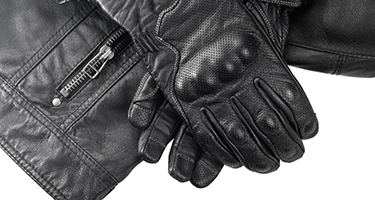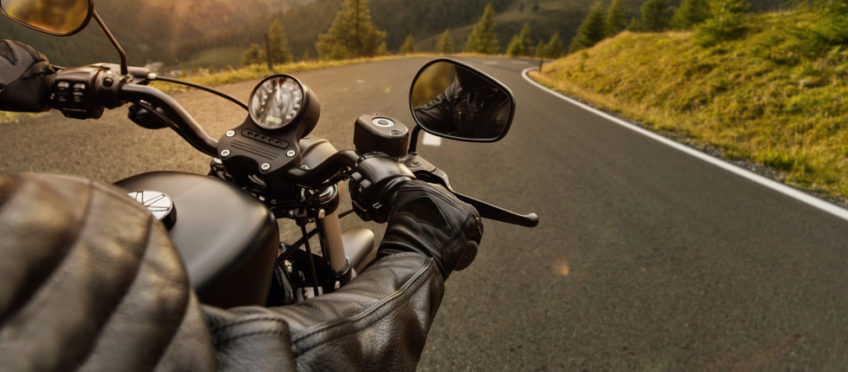We all want to look fabulous when we’re out riding, but making a fashion statement should be the last consideration when purchasing gear. Fit and function come first, in that order.
Protection from road rash or impacts is only part of gear’s usefulness. It also protects against a variety of road hazards like stones, bugs, cigarette butts, heat, cold, and rain, makes us more visible, and reduces fatigue.
Gear shopping is best done within access to a bike similar in size and style to the one you’ll be riding. Use this guide to select the best riding jacket and pants.
Fit
Sleeve/leg length.
Try on the garment, then sit on the bike as if you were riding, with your hands on the grips and feet on the pegs. Sleeves should cover your wrists; pant legs should cover your ankles. Jackets must be long enough to cover your lower back. This means sleeves and legs will look long when you’re standing away from the bike, but they’re designed to protect you while you’re riding.
 Adjustments.
Adjustments.
Look for adjustable waists to adapt to different sizes and body shapes and accommodate layers. Some jackets also have adjustments on the sleeves.
Tightness.
Snug, but not constrictive jacket and pants offer greater protection in a slide because they’ll hold the gear and armor in place for greater protection. A garment that’s too loose can get twisted and cause additional injury. A snug fit prevents fabric from flapping while you’re riding. Not only does flapping cause premature wear and unnecessary distraction, but it also adds to rider fatigue.
Style.
Select the style best suited to your interests—touring, adventure, or off-road riding. Each style has it’s own idiosyncrasies to give you the best protection and convenience for your brand of riding.
Function
Abrasion resistance.
We hope it never happens, but we depend on our gear to protect us if we come into contact with the road. Leather and textiles potentially offer a high degree of protection, but quality can vary substantially. Read the label to find out how much abrasion resistance the product offers.
Armor.
The best jackets have padding (armor) that protects elbows, shoulders, and back. Armor in pants protects hips and knees. While standing, padding will feel awkward and fall below the area it’s meant to protect. Once you assume the riding position, it moves into place. Some garments have pockets in the lining so you can adjust the protective inserts to suit your arm and leg length. Don’t be persuaded to accept flimsy pieces of foam that try to pass for protection. Look for CE-certified shoulder, elbow and kneepads and buy the highest quality you can afford. Make sure it’s removable so you can launder the gear.
Ventilation.
At a minimum, look for vents on the jacket chest and back for flow-through ventilation. Underarm vents add even more comfort on hot days. Pants tend to have less ventilation but some styles have zippered vents on the legs, or removable sections with underlying mesh. Look for big and sturdy zipper pulls to ease opening and closing vents with gloves while riding.
Pockets.
Seek out easily accessible interior and exterior pockets on a jacket and interior pockets on riding pants. If the jacket is marketed as waterproof, pocket zippers will have additional reinforcement to maintain their integrity.
Construction.
Riding garments have a variety of closures from zippers to Velcro to snaps. Make sure they’re high quality (even Velcro comes in different grades) and that the jackets themselves have been well assembled. Inspect seams, lining and closures for finishing details. Choose adjustable closures at wrists and neck. Although Velcro works anywhere else, stay away from it at your neck. It snags on helmet straps and causes premature wear.
Versatility.
When you’re starting out, you want as much function as possible while staying within your budget. Three-season jackets have an abrasion resistant, outer shell, a removable liner, and often, a zip-in rain liner. Rain liners sound like a great idea but they add little value. They may keep the rain out, but they’re uncomfortable, cause excessive perspiration (so you’re wet anyway), and stick to you, causing binding when you’re trying to move. Unless you insert them in anticipation of rain, they’re inconvenient to put on at the side of the road. Consider separate rain gear instead.
Visibility.
Anything you can do to make yourself more visible to other road users helps alert them to your presence. Reflective piping or inserts, especially on your jacket, may make the difference between someone noticing you and getting hit. Many jackets come in high-viz colors, although they tend to fade. A reflective vest with good airflow, worn over any jacket, is another option.
Weatherproofing.
A water-resistant feature is of limited usefulness. You may not plan to ride in the rain but if you’re doing any amount of riding, it’s going to happen. You’ll still need additional rain protection, even with water-resistant gear. While substantially pricier, the superior overall functionality of GORE-TEX®, or similar fabrics, can’t be beat.
Take your time, ask lots of questions, try on the gear and sit on a bike in a position similar to the one you use. Determine which features are important to you. A low price doesn’t always deliver value. Garments of inferior quality will wear out sooner, be less versatile, and offer less protection. When a salesperson is trying to close the deal, think through the logic of the features to your own application. You’re making a decision about your safety, so choose wisely.
You can also learn how to select the right gloves and boots, as well as the right helmet!








join the conversation